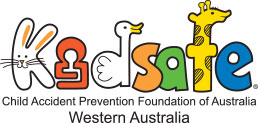
Button batteries are flat, round, coin-sized batteries that can cause severe injury and death if swallowed. They are commonly found in household products, such as hearing aids, novelty items, toys, musical greeting cards, remote controls, kitchen and bathroom scales and calculators. Diagnosis can be difficult as the symptoms of swallowing a button battery can be similar to other childhood illnesses. Symptoms can include coughing, drooling, discomfort, vomiting, abdominal pain, fever, diarrhoea and respiratory distress.
If a child is suspected of swallowing a button battery, call the Poisons Information Line on 13 11 26 immediately. However, if the child is choking or struggling to breathe, phone 000 for an ambulance.
Kidsafe WA has recently released the Childhood Injury Bulletin: Button Batteries, summarising presentations to the Perth Children’s Hospital Emergency Department over a five-year period. The bulletin found that children aged between 0 and 4 years accounted for 74% of button battery-related injuries. Children under the age of five are at particular risk of injury due to their narrow oesophagus and innate curiosity to place small objects into their mouth, ears and nose. When swallowed, a battery can get lodged in a child’s oesophagus. The saliva triggers an electrical current, initiating a chemical reaction that can cause severe burns and tissue damage within two hours of ingestion. Three children in Australia have died after swallowing a button battery.
In June 2022, mandatory safety standards were established in Australia to specify a minimum requirement in regard to secure battery compartments for products, child-resistant packaging, compliance testing and additional warning labels and emergency advice. Products must now meet the mandatory standard before they can be sold in Australia. The following preventative measures can assist in reducing the risk of button battery injuries:
Retailers:
- Only carry products that comply with the mandatory button battery safety standards.
- Encourage consumers to purchase alternative products that do not use button batteries, where the battery does not need to be replaced and can be recharged.
- Displayed button batteries at a sufficient height to prevent small children from accessing them.
Consumers:
- Avoid buying products that use button batteries. Look for those with an alternate power source.
- Purchase button battery-operated products with a child-resistant battery compartment. Products purchased from overseas suppliers may not be child-resistant.
At home:
- Identify devices around your home that may contain button batteries.
- Ensure battery compartments are secure, regardless of whether the device is intended for a child.
- Place button batteries and devices that contain them out of reach and out of sight of young children.
- Inspect toys and other items regularly to ensure the button battery compartment is still secure.
- Stop using the product if it is damaged or the button battery compartment does not close securely.
- Dispose of batteries safely by wrapping them in sticky tape and putting them in a child-resistant container, out of reach of children until you can recycle them at a battery recycling collection point. Even old button batteries can be dangerous.
To view the full report, visit https://www.kidsafewa.com.au/professionals/wa-childhood-injury-bulletins-reports/



